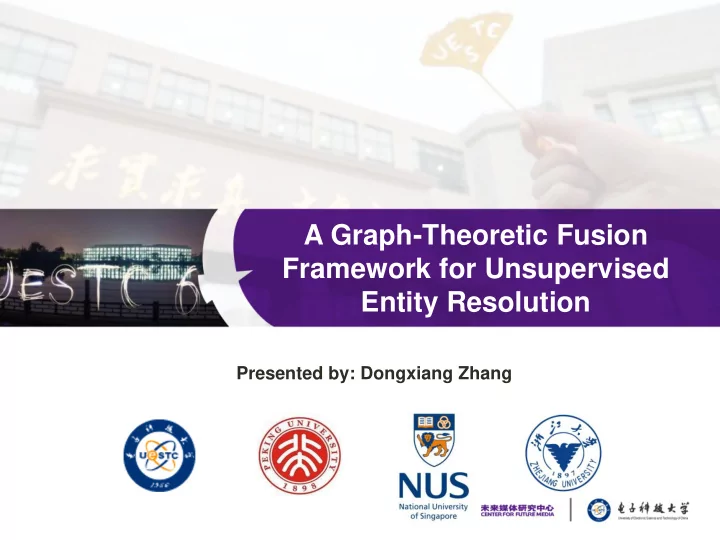

A Graph-Theoretic Fusion Framework for Unsupervised Entity Resolution Presented by: Dongxiang Zhang
Entity Resolution Text Rec ecords Ide Identical Ent Entity Les Celebrites 160 Central Park S New York French √ Les Celebrites 155 W. 58th St. New York City French (Classic) Palm 837 Second Ave. New York City Steakhouses × Palm Too 840 Second Ave. New York City Steakhouses Two examples from the restaurant dataset.
Previous Work Distance-based Methods • Edit Distance, TF-IDF • Simple and scalable, but not effective enough Learning-based Methods • Learn a distance metric • Model ER as a classification task and apply SVM • Require considerable amount of training data Crowd-based Methods • CrowdER, TransM, TransNode, GCER, ADC, Power+ • Achieve state-of-the-art accuracy but require human intervention
Our Objective Propose an unsupervised approach • More accurate when compared with distance-based methods • Require no training/labeling efforts when compared with learning-based methods • Require no human intervention and financial cost when compared with crowd-based methods
The General Idea In the traditional unsupervised methods • Step 1: Craft a distance measure between two records • Step 2: Tune a threshold such that two records with similarity score higher than the threshold are considered as the same entity We are motivated to improve these two steps by • Proposing ITER algorithm to learn record similarity • Proposing CliqueRank to estimate the likelihood of two records referring to the same entity • Iteratively Reinforcing these two components
Unsupervised Fusion Framework CliqueRank ITER
ITER Algorithm If a term only occurs in a group of matching records, then we consider the term as highly discriminative • Examples include product models for electronic devices or telephone numbers for restaurant. • These terms have low term frequency and may not be emphasized by TF-IDF If a term is shared by many non-matching records, its weight will be punished
ITER Algorithm
ITER Algorithm
CliqueRank Algorithm Given Gr, our goal is to identify matching probability. Ideally, the probability should be 1 for matching pairs and 0 for non-matching pairs
CliqueRank Algorithm Random-Walk based interpretation Ideally, if r i and r j refer to different entities, they should be located in different cliques and not reachable from each other Otherwise, if we start a random walk from one record r i , it will be very likely to visit the other record r j within certain number of steps
Random-Surfer Sampling
Random Walk Algorithm To handle large cliques To champion edge with high score For early termination
CliqueRank Algorithm Iterative sampling is slow, and we switch to matrix operation be the matrix with reaching probability from r i to r j with 1 step be the matrix with reaching probability from r i to r j with S steps The random surfer algorithm essentially estimates such probability
CliqueRank Algorithm We make customizations to the RSS algorithm be the initial transition probability matrix is set to 1 if r i to r j are connected in Gr Finally, we can define the reaching probability with S steps
Benchmark Datasets Restaurant • 858 non-identical restaurant records. • Each record contains the information of restaurant name and address. Product • 1081 records from the abt website and the other 1092 records from the buy website. • Each product record contains its name and descriptive information. Paper • 1865 non-identical publication records. • Each record has a cluster id and its textual information consists of authors, title, publication venue and year.
Experimental Setup For the three datasets, we use the same setting of parameters • α =20 • S=20 • η =0.98 • 5 iterations between the reinforcement of ITER and CliqueRank Eigen library is used to boost matrix multiplication http://eigen.tuxfamily.org/index.php?title=Main Page
Experiment & Analysis Accuracy
Experiment & Analysis Efficiency
Experiment & Analysis Effectiveness of Learned Term Weights ground-truth score:
Experiment & Analysis Top-Ranked Terms in the Benchmark Datasets
Experiment & Analysis Convergence of ITER
Experiment & Analysis Effect of Reinforcement
Conclusion We propose an unsupervised graph-theoretic framework for entity resolution. Two novel algorithms ITER and CliqueRank are proposed, one for term-based similarity and the other for topological confidence. These two components can reinforce each other. Experimental results on three benchmark datasets show that our algorithm is accurate Codes are available at: https://github.com/uestc-db/Unsupervised-Entity-Resolution
Thank you! Q&A
Recommend
More recommend